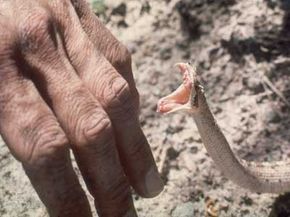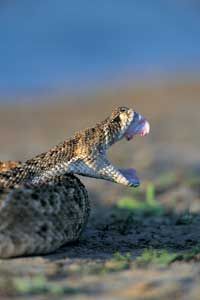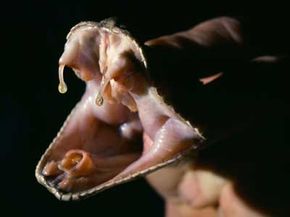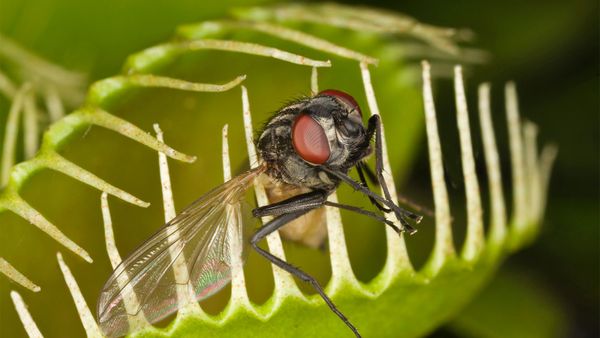Before we discuss snakebite treatment, it's important to note that the chances of receiving a venomous snakebite are very low. Worldwide, there are between 1 and 2 million snakebite incidents per year. However, those numbers result in only 50,000 to 100,000 snakebite fatalities [source: Reptile Gardens] -- and remember, that's on the entire planet.
Within the United States, for example, just five percent -- about 25 species -- of snakes are venomous [source: NYP]. Rattlesnakes account for about 70 percent of venomous snakebites in the U.S. and for almost all of the snakebite deaths [source: Merck]. However, only one out of 50 million people in the U.S. will die each year from a snakebite [source: Johnson]. So relax.
How do you tell the difference between a venomous snake and a non-venomous snake? Many experts point to the snake's eyes. Non-venomous snakes have round pupils. Venomous snakes have elliptical pupils, like a cat's. Additionally, pit vipers, all of which are venomous, have a small hole or pit between the nostril and the eye. Of course, this information implies that you're supposed to bend over and peer into the creature's face, which wouldn't be very smart. The best and safest way to determine whether a snake is venomous is to familiarize yourself with the snakes local to your area and memorize their color bands or markings. For example, the venomous coral snake and the harmless milk snake, or scarlet snake, look nearly identical, except for the order of their red, black and yellow bands. To tell the difference, children are taught the rhyme, "Red touch black, venom lack. Red touch yellow, kill a fellow."
If a snake does bite you, look out for the symptoms of a venomous bite. Symptoms vary according to the size and species of snake. Pit vipers are the most common venomous snakes in the United States and include all rattlesnakes. The first symptom of a pit viper bite is usually pain, followed by redness and swelling within 20 to 30 minutes. Other signs include chills, fever, weakness, nausea or breathing difficulties. Also look out for blurred vision or droopy eyelid. Severe bruising can occur several hours after the bite. Coral snakebites, on the other hand, usually don't result in immediate pain. The symptoms may take several hours to develop and include tingling, muscle weakness, swallowing difficulties, excess saliva and potentially fatal breathing problems. You should always seek medical assistance immediately to determine whether the snake that bit you was venomous -- even if you're not in pain at the time.
You might be wondering how long it would take a venomous snakebite to kill you. It's hard to answer that question because there are so many variables involved. It depends on how much venom was released into your system, whether you go into shock, what your immune system can handle, how soon you seek treatment, how your body responds to treatment and the list goes on. But one thing's for certain: The sooner a snakebite receives medical attention, the better.
Prevention, of course, is the best medicine. Try to avoid areas where a snake might hide, like under rocks and logs. We probably don't have to tell you that it's not a good idea to pick up or tease snakes, even if you think they're not venomous. Don't provoke a snake, either. When you're hiking in snake-populated areas, wear long pants and boots. If you're about to step into an area where you can't see your feet (like heavy underbrush), tap first with a walking stick.















